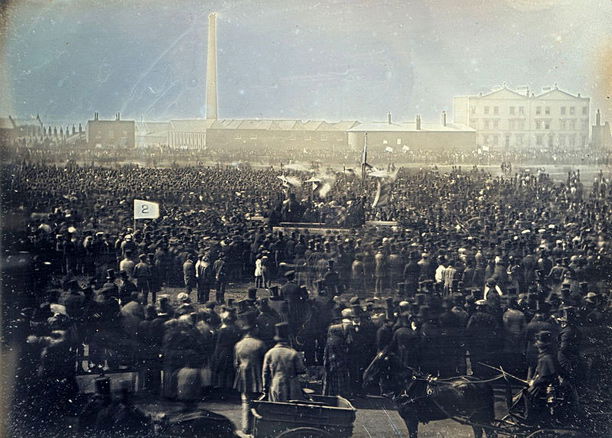Failed Chartist Demonstration in London
Britain's working-class Chartist movement organised a mass meeting at Kennington Common on April 10th, 1848.
 The death-knell of the Chartist movement in Britain sounded on what was meant to be its day of triumph. In a year when thrones tottered and regimes quailed as revolutions broke out all over Europe, the Chartist leaders organised a demonstration on Kennington Common in South London, across the Thames from the Houses of Parliament, on April 10th, 1848. Their campaign for universal manhood suffrage, vote by secret ballot in elections and other democratic reforms of the parliamentary system, as demanded in the People’s Charter of ten years before, enjoyed mass working-class support and the new 1840s railway system enabled working men from all over the country to assemble in one place far more easily than ever before. The idea was that an intimidatingly huge crowd would march from Kennington Common (now Kennington Park) to Parliament and deliver a monster petition.
The death-knell of the Chartist movement in Britain sounded on what was meant to be its day of triumph. In a year when thrones tottered and regimes quailed as revolutions broke out all over Europe, the Chartist leaders organised a demonstration on Kennington Common in South London, across the Thames from the Houses of Parliament, on April 10th, 1848. Their campaign for universal manhood suffrage, vote by secret ballot in elections and other democratic reforms of the parliamentary system, as demanded in the People’s Charter of ten years before, enjoyed mass working-class support and the new 1840s railway system enabled working men from all over the country to assemble in one place far more easily than ever before. The idea was that an intimidatingly huge crowd would march from Kennington Common (now Kennington Park) to Parliament and deliver a monster petition.
The authorities in London braced themselves to meet the threat. The great Duke of Wellington, who was almost eighty but still stood no nonsense, was put in charge. Calming nervous cabinet ministers, he made his arrangements with his accustomed sagacity. Cavalry and infantry were stationed at the south side of the bridges across the Thames and more troops were held in reserve along the north side, but all were kept as far as possible out of sight, to avoid provocation. Steamboats waited on the river to move troops to threatened locations as needed, and 10,000 men could have been concentrated in minutes at any given spot. Cannon were readied close to Buckingham Palace. The entrances to government buildings were blocked with books and files of papers, ministers’ homes were specially protected, soldiers guarded the Bank of England and rifles were issued to the clerks in the General Post Office. Meanwhile, more than 170,000 citizens were sworn in as special constables to assist the police. They were provided with truncheons and white arm bands, and their ranks included Mr Gladstone, Sir Robert Peel and Prince Louis Napoleon Bonaparte, the future Emperor Napoleon III of France, who shared his beat in Piccadilly with the Athenaeum Club’s chef. Also enrolled were all the London coal whippers, who unloaded coal from ships in the docks, and were extremely proud of having turned out to a man.
The demonstration proved to be a damp squib, which petered out in pelting rain. Early in the morning, groups of Chartists gathered in Russell Square, Finsbury Square, Clerkenwell Green and Whitechapel, and peacefully crossed the bridges over to the south bank. Eventually some 20,000 to 25,000 of them (up to 200,000 had been expected) assembled on Kennington Common, where they found themselves, in effect, in a trap. The police simply refused to let them cross Westminster Bridge and the other bridges back to the north bank of the Thames. A police inspector, described as ‘of gigantic stature and good-natured aspect’, escorted the most charismatic of the Chartist leaders, Feargus O’Connor MP, noted mob orator and descendant of Irish kings, to talk to Richard Mayne, the London police commissioner, who told him his followers were not to cross to the north bank. Not prepared to force their way over, the Chartist leaders humiliatingly agreed to convey O’Connor and the petition across the river by Westminster Bridge in three hired hansom cabs. The crowd on Kennington Common melted damply away in the rain and by 2 o’clock in the afternoon Lord John Russell, the prime minister, was able to report to Queen Victoria that the Chartist meeting had been a total failure.
The petition, meanwhile, which was boasted to have over 5,700,000 signatures, proved to contain just under 2 million. Pages of them were in identical handwriting and many of them were forged or facetious, including those of the Queen and the Iron Duke, who appeared to have endorsed the petition no fewer than seventeen times, along with Mr Punch and names like Pugnose and No Cheese. O’Connor, who never recovered from the indignity of it all, went certifiably insane four years later. Chartism was effectively dead, and it was to be many years before its demands became part of the accepted democratic system in Britain.




